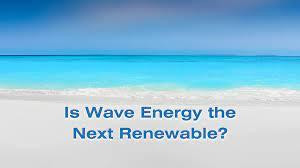Introduction: Wave energy, a renewable and sustainable form of energy, holds tremendous potential in meeting the world's growing energy demands while mitigating environmental impacts. In this article, we delve into what wave energy is, its mechanisms, and the advantages it offers as a promising source of clean power.
What is Wave Energy? Wave energy, also known as ocean wave power, refers to the energy harnessed from the motion of ocean waves. It is a form of renewable energy derived from the kinetic energy of ocean waves, which are generated by the wind as it blows over the surface of the sea. Waves carry vast amounts of energy across oceans, making them a valuable resource for electricity generation.

Mechanisms of Wave Energy Conversion: Wave energy conversion involves capturing the energy present in ocean waves and converting it into electricity through various technologies. These technologies typically utilize the motion of waves to drive turbines or other devices that generate electricity. Some common mechanisms of wave energy conversion include oscillating water columns, point absorbers, attenuators, and oscillating wave surge converters.
- Abundant and Renewable: One of the primary advantages of wave energy is its abundance and renewability. Waves are a constant and inexhaustible energy source, driven by the gravitational pull of the moon and the sun and the Earth's rotation, making them available around the clock and throughout the year.
- Low Environmental Impact: Unlike fossil fuels, wave energy is a clean and environmentally friendly alternative. Its extraction does not produce greenhouse gas emissions or contribute to air or water pollution. Additionally, wave energy projects can be designed to have minimal impact on marine ecosystems and coastal landscapes, preserving biodiversity and natural habitats.
- Predictable and Consistent: Wave energy is highly predictable, as waves are influenced by weather patterns and seasonal variations. This predictability enables efficient planning and management of wave energy projects, ensuring a stable and reliable source of electricity generation.
- Energy Security: Wave energy offers enhanced energy security by diversifying the energy mix and reducing reliance on finite fossil fuel resources. By harnessing the power of the ocean, countries can strengthen their energy independence and resilience to supply disruptions, contributing to a more sustainable and secure energy future.
- Long-Term Cost Effectiveness: While initial investment costs for wave energy projects may be relatively high, the long-term cost effectiveness of wave energy is promising. Once operational, wave energy systems require minimal ongoing costs for fuel and maintenance, leading to stable and predictable electricity prices over the project's lifespan.
- Scalability and Potential for Integration: Wave energy technologies are scalable and can be deployed on various scales, from small-scale installations to large commercial projects. Furthermore, wave energy has the potential to complement other renewable energy sources such as wind and solar power, providing a diversified and integrated approach to sustainable energy generation.
Conclusion: In conclusion, wave energy represents a promising frontier in the transition towards a more sustainable and resilient energy future. With its abundant availability, low environmental impact, predictability, and long-term cost effectiveness, wave energy holds immense potential to contribute significantly to global energy needs while reducing greenhouse gas emissions and mitigating climate change. Embracing and investing in wave energy technologies can pave the way for a cleaner, greener, and more prosperous future for generations to come.






Comments